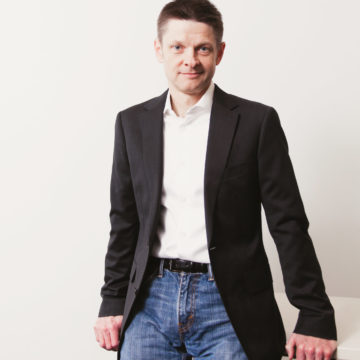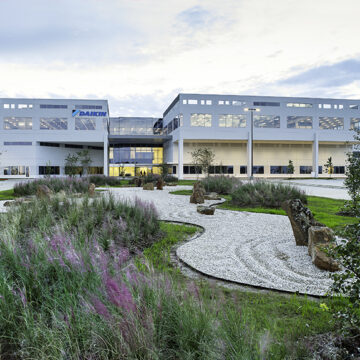The Misalignment of Ultimate Design Features with Their Proximate Manifestations
- Perspectives
Note: This essay was originally featured in Constructing Our Niches: The Application of Evolutionary Theory to the Architecture, Engineering, and Construction (AEC) Industry at evolution-institute.org.
In the previous essay, I began exploring how evolutionary theory can guide cooperative decision making and the development of policy that benefits more of us collectively, for longer periods of time. In this essay, I build on these previous discussions to further explore how misalignment of the physical and social/cultural environment’s proximate manifestations with the relevant ultimate design features’ requirements results in varying degrees of failure. Specific real-world examples are one of the most effective ways to demonstrate this.
As a professional who frequently evaluates the building/occupant organism, I’ve seen how thermal comfort inequities across a building or campus undermine Ostrom’s design feature 1 (a strong group identity, including understanding and agreeing with the group’s purpose).45,46 Something I’ve commonly observed working for BranchPattern, is varying levels of thermal comfort and personal temperature control across any given pre-K – 16+ campus. The reasons are wide-ranging, consisting of everything from poorly designed or constructed building envelopes, to multiple spaces sharing a single thermostat (exacerbated when those spaces have different heating/cooling needs), to ignoring how the human body actually transfers heat (refer to the second essay in this series), to inadequately accounting for how variation in demographics (age, gender, clothing, etc.) impacts thermal comfort.

Administration offices – some share a thermostat. As a result, some
individuals are at the mercy of their colleagues for their thermal comfort.
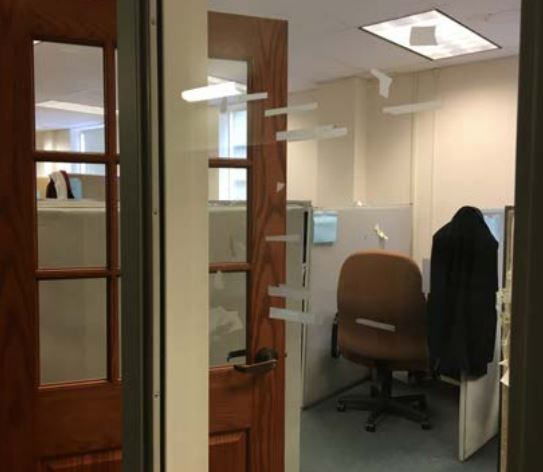
Multiple graduate students sharing a single room with one thermostat;
the room had previously been converted to this use.
In situations where multiple classrooms or administrative offices share a single thermostat, or where teachers/staff share a single space, I have observed conflicts over thermostat control that range from small degrees of tension to open hostility. Passive-aggressive actions, such as the repeated adjustment of thermostats up or down in the absence of the other person, aren’t uncommon. Where multiple rooms are controlled by a single thermostat, the individual with the thermostat may lock their door when absent to keep the other person(s) from making adjustments. Some individuals avoided making thermostat adjustments for fear of negatively impacting others, or for fear of how others would react. Even when teachers/staff were willing to share control, the thermostat setting became another point of negotiation (sometimes multiple times a day) for teachers/staff who are already overworked, underpaid and stressed. Here are a few survey response examples:
- Two teachers to a room affect this especially when the one closest to the thermostat is going through menopause.
- I would like to be able to control my office without affecting others. IE: the control is in nurse’s office and sometimes their temp. N[n]eeds to be warmer or vice versa.
- Our room is often hot AND cold. I share a space with another teacher though and sometimes I think she may be turning the thermostat up and down throughout the day.
- I do not have any outside windows in my classroom. I rely on the teacher next door to control thermostat in my room. Sometimes, just a fan would be nice to move the air around.
- One person has a thermostat in their office and they keep their door shut all the time.
- Inability to control the temperature in our individual offices. It’s sometimes stifling hot in the summer and very cold in the winter, and we can’t adjust. Also if the person in the office next door is not in, there is no way to adjust the temperature.
Passive-aggressive actions, such as the repeated adjustment of thermostats up or down in the absence of the other person, aren’t uncommon.
And here are a few examples from interviews conducted with teachers:
- One faculty with the controlling thermostat in their office apparently keeps his/her door shut all the time, according to one of the other faculty on the same zone (stated a bit annoyingly).
- One faculty with the controlling thermostat stated that no one had ever asked him to make an adjustment, but he wasn’t sure if that’s because there weren’t any issues or if other faculty were uncomfortable asking him.
- One faculty had jokingly warned the adjacent faculty member with the controlling thermostat that he was going to bring in a freeze-bag to put on the thermostat.
In some cases, teachers and staff end up resenting administration and maintenance for allowing the system to have been designed in this manner, or for not making changes to rectify the issue. They sometimes end up resenting their colleagues residing in rooms with their own thermostats, as those without individual control commonly expressed envy of those who did – it created a have/have-not dynamic. These temperature control conflicts that sometimes involve visible inequities and forms of social undermining behavior negatively impact the ability to collaborate, the degree of cohesiveness and trust, and the working relationships in general among colleagues.52,53
In some cases, teachers and staff end up resenting administration and maintenance for allowing the system to have been designed in this manner, or for not making changes to rectify the issue.
In these situations, the rules and expectations for obtaining thermal comfort end up varying by role and/or location. As a result, different sub-groups are created, separated by a thermal comfort boundary. In the end, we have a school of teachers and staff whose ability to effectively collaborate in the pursuit of a common educational goal is compromised compared to a school with effective means of providing individual temperature control.
Unfortunately, such examples of misalignment between a specific physical environment’s capabilities and the ultimate requirements of design feature 1 (strong group identity) commonly extend beyond thermal comfort inequities (though the degree of impact varies). The photo below was taken from within the media center of a New Mexico high school. The center was designed with large expanses of exterior/interior glazing flooding daylight inwards and providing beautiful outward views for the teachers and students (as well as facilitating the requirements of design feature 4 – low-cost monitoring, so that lapses of cooperation can be easily detected). Here you can see the internal glazing at an upper level, allowing views to the lower ground level, as well as beyond through the exterior glazing (not pictured).
While this solution allows substantial daylight penetration and view access, the space’s configuration, as the librarian pointed out to me, also allows those at the ground level to see up the skirts of individuals standing next to the glass on the upper level. As a result, the structure of the media center’s physical environment exacerbates potential occurrences of sexual harassment (staff to staff, student to student or between these groups) and other conflicts surrounding gender and bullying. It creates additional opportunities for harassment, discrimination, embarrassment, disrespectful behavior and bullying to occur. All of which create and/or exacerbate existing divisions within the larger school, working against design feature 1. What’s more, this misalignment could have easily been rectified had some type of applique or film been applied to the lower portion of the glazing.
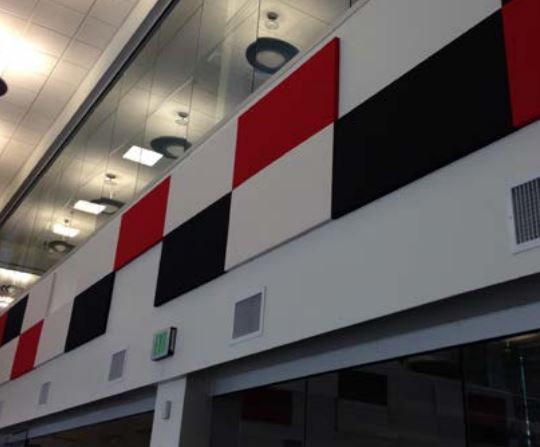
High school media center – upper level glazing extends to the floor of the upper level.
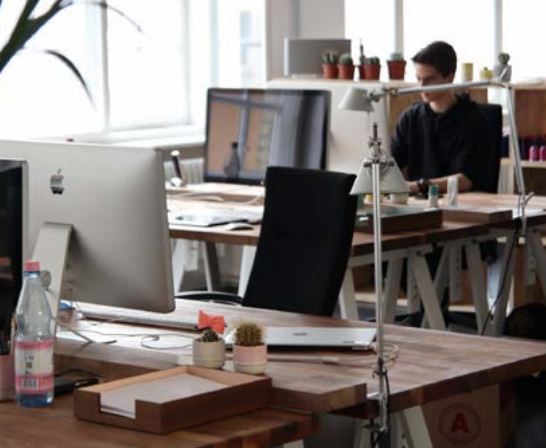
Example of a free address environment – workstations depicted. This is not a photo of the office environment referred to in this essay.
Moving to an example from the corporate sector, we’re currently assisting one of our corporate clients assess a free address pilot in one of their office buildings. Free address environments, also termed hot-desking, non-territorial or untethered environments, typically consist of a variety of locations and settings throughout an office that occupants may select from depending on the tasks being conducted at any given time. Such locations often consist of individual workstations, phone rooms, team or huddle rooms for individual or small group work, conference rooms of varying size, and various configurations of open spaces using a variety of furniture types. Technology is usually present throughout the office for video conferencing, conference calls, and to assist with collaboration in general.
Free address environments are often implemented in conjunction with remote working, telecommuting, job sharing, and compressed work week policies to help a) minimize total constructed or leased square footage and square footage per employee, b) maximize space utilization, c) minimize move/reorganization costs, and d) improve collaboration and communication. Though research54,55,56 indicates free address environments have mixed success rates.
Our client’s pilot floor plates generally consist of a) areas of unassigned workstations (first come, first served) located side by side where occupants can dock their laptops, b) more open areas furnished with a mixture of tables/chairs, less formal furniture, and mobile whiteboards and c) various conference rooms and smaller rooms for personal phone calls, heads down work and collaboration. Most of these are non-reservable. Lockers are also available for occupants to store their personal belongings during the day. While employees aren’t assigned to a specific workstation, individuals (and their departments) are assigned a specific area on a given floor, though one may choose to work in other areas and even other floors if a spot is available. We’re still in the middle of our assessment, but some observations can be made regarding the free address environment’s alignment with Ostrom’s design features.
Free address environments are often implemented in conjunction with remote working, telecommuting, job sharing, and compressed work week policies.
There are protocols and best practices for working on these floors that occupants are expected to follow to help ensure a collaborative, comfortable and productive environment that benefit the occupants, their teams, and ultimately the organization. A few of these include:
- Leave the shared spaces (including workstations) as they were found, or as occupants would generally like them to be found upon their arrival each day. Everything brought with an occupant to a workstation or other space must be taken with the occupant or stored in a locker at the end of the day.
- Eat food in the café area as opposed to in the work areas (to minimize distracting odors as well as limit workspace messiness).
- For reservable spaces, be mindful of others who may also need to use them (don’t hog them).
- Adapt to meet their own personal needs. Examples include wearing earbuds or moving to other locations.
- Respectfully communicate their (unmet) needs to those around them.
Each of these free access floors have a high degree of openness; it’s easy to see, hear, smell, etc., what your neighbors are doing. The physical environment’s proximate manifestation obviously helps facilitate design feature 4 (low-cost monitoring, so that lapses of cooperation can be easily detected) – it’s easy to detect violations of most of the protocols and best practices.
For reservable spaces, be mindful of others who may also need to use them.
Once violations are detected, enforcement of the protocols and best practices appears to primarily be by a) peer pressure, b) a concierge assigned to oversee various floors, and c) mid-level managers. Sanctions, as addressed in design feature 5 (graduated sanctions to correct misbehaviors, which begin with friendly reminders and escalate only as needed), look to consist of verbal reminders from neighbors and the concierge and mid-level managers, with potentially increasing weight given to those reminders as you work up the chain. Non-verbal communication, including body language, sticking in earbuds (with exaggerated movements), sighs, etc., are also part of the communication received from neighbors. Conflict resolution relative to the protocols and best practices among occupants (design feature 6 – conflict resolution that is fast and perceived as fair by group members) is to be handled by the concierge first, and then mid-level managers if needed.
Initial assessments of survey results and incontext interviews and observations suggest that the peer pressure, sanctions and means of conflict resolution (design features 5 and 6) aren’t consistently effective in enforcing the free address protocols and best practices, as well as resolving associated conflicts. Potential contributing factors include:
- Increased potential for dissatisfaction and conflict. Free address environments can greatly limit the amount of control occupants have over their comfort, the nature of their workspace, and how they do their work. If a) the general indoor environmental quality (temperature, lighting, acoustics, etc.), b) the number and locations of supplemental space types (heads down work rooms, collaboration spaces, conference rooms, etc.), and c) associated protocols, best practices, etc. (including sanctions and means of conflict resolutions) aren’t effective in meeting employee and team needs, occupants will more likely violate the protocols and best practices in pursuit of their needs.
- Cross-cultural differences associated with the use of contract employees who are primarily from a non-western country. Many of these individuals have norms that differ with regards to personal space, privacy, territoriality, food, and food odor preferences, and peer pressure. This appears to be creating or exacerbating misunderstandings and conflicts between the contract employees and permanent employees around the protocols and best practices.
- Uncertainty among some occupants regarding who to speak to (or how to get in touch with the appropriate person) to resolve conflicts associated with the protocols and best practices, when peer pressure doesn’t seem to work.
Free address environments can greatly limit the amount of control occupants have over their comfort, the nature of their workspace, and how they do their work.
This is a very preliminary assessment, but it nevertheless demonstrates the importance of aligning the physical and social/cultural environment’s proximate manifestations with the requirements of the relevant ultimate design features (Ostrom’s design features in this case). But some within the industry will point out that the design/construction process has an inherent give and take to it. Compromises will always have to be made as the design process seeks to optimize a balance (within budgetary and schedule constraints) between the vast number of pros and cons for a given client, building and occupant group. Some degree of misalignment is inevitable. Many of those same individuals would also point out that these misalignments often develop over time as occupants, space use requirements, societal expectations, etc., change. The building/occupant organism doesn’t remain fixed once the contractor leaves the job site, and it should be viewed as an evolving entity requiring periodic adjustments, modifications and renovations.
I would agree with both points. However, my point is that by not deliberately determining what the relevant ultimate design features (and their appropriate proximate manifestations) are for a given social/cultural and physical environment, we increase the likelihood that misalignments similar to the ones discussed above will occur. And this increases the likelihood that the success of the organization in question will be negatively impacted. We can minimize the occurrences of misalignment (and the degree of their severity) by proactively taking the nature of the relevant ultimate and proximate design features into account.
Up to this point, I’ve focused on Ostrom’s eight design features, but there are other ultimate design features that should be considered as well. The next essay will broaden the discussion of ultimate design features for the building/construction industry.
Sources:
1. Dunnell, R.C. (1980). Evolutionary Theory and Archaeology. Advances in Archaeological Method and Theory. Vol. 3 (1980), pp. 35-99.
2. Leonard, R. D. (2001). Evolutionary Archaeology. In Archaeological Theory Today, edited by I. Hodder, pp. 65-97. Polity Press, Cambridge, UK.
3. Dawkins, R. (1982). The Extended Phenotype. Oxford University Press, Oxford, UK.
4. Dawkins, R. (1989). The Selfish Gene. New ed. Oxford University Press, Oxford, UK.
5. Dunnell, R.C. (1989). Aspects of the Application of Evolutionary Theory in Archaeology. In Archaeological Thought in America, edited by C. C. Lamberg-Karlovsky, pp. 35-49. Cambridge University Press, Cambridge, UK.
6. Dunnell, R.C. (1995). What is it that Actually Evolves? In Evolutionary Archaeology: Methodological Issues, edited by P. A. Teltser, pp. 33-50. University of Arizona Press, Tucson.
7. Leonard, R. D., and G. T. Jones (1987). Elements of an Inclusive Evolutionary Model for Archaeology. Journal of Anthropological Archaeology 6:199-219.
8. O’Brien, M. J. and R. L. Lyman (2000a). Applying Evolutionary Archaeology: A Systematic Approach. Kluwer Academic Press/Plenum Press, New York.
9. Harmon, M. J. (2005). Centralization, Cultural Transmission, and “The Game of Life and Death” in Northern Mexico. Ph.D. Dissertation, Department of Anthropology, University of New Mexico, Albuquerque.
10. Sober, E. and D. S. Wilson (1998). Unto Others: The Evolution and Psychology of Unselfish Behavior. Harvard University Press, Cambridge and London
11. Wilson, D. S. (1998). Hunting, Sharing, and Multilevel Selection. Current Anthropology 39(1):73-97.
12. Wilson, D. S. (2002). Darwin’s Cathedral: Evolution, Religion, and the Nature of Society. The University of Chicago Press, Chicago and London.
13. Harmon, M. J. (2008). The “Game of Life and Death” Within the Casas Grandes Region of Northern Mexico. In Touching the Past: Ritual, Religion, and Trade of Casas Grandes, BYU Museum of Peoples and Cultures Popular Series No. 5, edited by G. Nielsen-Grimm and P. Stavast. The University of Utah Press, Salt Lake City.
14. Harmon, M. J., T. L. VanPool, R. D. Leonard, C. S. VanPool, and L. A. Salter (2006). Reconstructing the Flow of Information Across Time and Space: A Phylogenetic Analysis of Ceramic Traditions from Prehispanic Western and Northern Mexico and the Southwestern United States. In Mapping Our Ancestors: Phylogenetic Methods in Anthropology and Prehistory, edited by C. P. Lipo, M. J. O’Brien, S. Shennan, and M. Collard. Aldine Transaction, New Brunswick and London.
15. Lipo, C. P., M. J. O’Brien, S. Shennan, and M. Collard, editors (2006). Mapping Our Ancestors: Phylogenetic Methods in Anthropology and Prehistory. Aldine Transaction, New Brunswick and London.
16. Mace, R., C. J. Holden and S. Shennan, editors (2005). The Evolution of Cultural Diversity: A Phylogenetic Approach. Left Coast Press, Inc. Walnut Creek, CA
17. O’Brien, M. J. and R. L. Lyman (2000b). Evolutionary Archaeology: Reconstructing and Explaining Historical Lineages. In Social Theory in Archaeology, edited by M. B. Schiffer, pp. 126-142. University of Utah Press, Salt Lake City.
18. O’Brien, M. J., Darwent, J., and R. Lee Lyman (2001). Cladistics is Useful for Reconstructing Archaeological Phylogenetics: Palaeoindian Points from the Southwestern United States. Journal of Archaeological Science 28:1115-1136
19. Moe, K. 2010. Thermally Active Surfaces in Architecture. Princeton Architectural Press, Hudson, NY.
20. Brager, G., H. Zhang, and E. Arens. 2015. Evolving opportunities for providing thermal comfort. Building Research and Information, Vol. 43, No. 3, 1–14. Retrieved from http://dx.doi.org/10.1080/09613218.2015.993536. www.escholarship.org/uc/item/77c0q85j.
21. Cheung, S. S., J. K. W. Lee and J. Oksa. 2016. Thermal Stress, Human Performance, and Physical Employment Standards. Applied Physiology, Nutrition, and Metabolism 41(6): S148-S164. Retrieved from https://doi.org/10.1139/apnm-2015-0518.
22. Hanna, E. G. and P. W. Tait. 2015. Limitations to Thermoregulation and Acclimatization Challenge Human Adaptation to Global Warming. International Journal of Environmental Research and Public Health 12(7): 8034-8074. Retrieved from https://www.ncbi.nlm.nih.gov/pmc/articles/PMC4515708/.
23. Lucas, R. A., Y. Epstein, and T. Kjellstrom. 2014. Excessive Occupational Heat Exposure: A Significant Ergonomic Challenge and Health Risk for Current and Future Workers. Extreme Physiology & Medicine. 3:14. Retrieved from https://www.ncbi.nlm.nih.gov/pmc/articles/PMC4107471/.
24. Mishra, A. K., M. G. L. C. Loomans, J. L. M. Hensen. 2016. Thermal Comfort of Heterogeneous and Dynamic Indoor Conditions – An Overview. Building and Environment 109(15): 82-100. Retrieved from http://www.sciencedirect.com/science/article/pii/S0360132316303560#bib4.
25. Xiang, J., P. BI, D. Pisaniello, and A. Hansen. 2014. Health Impacts of Workplace Heat Exposure: An Epidemiological Review. Industrial Health 52(2): 91-101. Retrieved from https://www.ncbi.nlm.nih.gov/pmc/articles/PMC4202759/.
26. Wilson, D.S. 2015. Does Altruism Exist? Culture, Genes, and the Welfare of Others. New Haven, CT: Yale University Press.
27. Wilson, D.S. 2017. Reaching a New Plateau for the Acceptance of Multilevel Selection. This View of Life, September 22, 2017. Retrieved from https://evolution-institute.org/focus-article/reaching-anew-plateau-for-the-acceptance-of-multilevel-selection/?source=tvol.
28. Horr, Y. A., M. Arif, A. Kaushik, A. Mazroei, M. Katafygiotou, and E. Elsarrag. 2016. Occupant Productivity and Office Indoor Environment Auality: A Review of the Literature. Building and Environment 105: 1-21.
29. Kats, G., L. Alevantis, A. Berman, E. Mills, and J. Perlman. 2003. The Costs and Financial Benefits of Green Buildings: A Report to California‟s Sustainable Building Task Force. Report developed for the California Sustainable Building Task Force.
30. Seppanen, O., W. J. Fisk, and Q. H. Lei. 2006. Effect of temperature on task performance in office environment. Report LBNL-60946. Helsinki University of Technology, 1-9
31. Cashman, S. 2017. The Moral History of Air-Conditioning. The Atlantic. Aug. 9, 2017. Accessed Aug 18, 2017. Retrieved from https://www.theatlantic.com/technology/archive/2017/08/the-moralhistory-of-air-conditioning/536364/
32. Ingels, M. 1952. Willis Haviland Carrier, Father of Air Conditioning. Country Life Press, Garden City, NY.
33. Basile, S. 2014. Cool: How Air Conditioning Changed Everything. Fordham University Press, NY.
34. Addington, M. 1995. Reclaiming the Boundary. Proceedings of the 83rd ACSA Annual Meeting, 460-464.
35. Ali, M. and P. Armstrong. 2010. Sustainability and the Tall Building: Recent Developments and Future Trends. Council on Tall Buildings and Urban Habitat, Chicago, IL.
36. Wood, A. and R. Salib. 2013. Guide to Natural Ventilation in High Rise Office Buildings. Routledge Taylor & Francis Group, New York, NY.
37. Beamish, T. D. and N. W. Biggart. 2010. Mesoeconomics: Business Cycles, Entrepreneurship, and Economic Crisis in Commercial Building Markets. In M. Lounsbury, P. M. Hirsh (Ed.), Markets on Trial: The Economic Sociology of the U.S. Financial Crisis: Part B, pp. 245-282, Emerald Group Publishing Limited, UK.
38. Johnson, C. E. and R. Kennedy. 2006. House in a Box: Prefabricated Housing in the Jackson Purchase Cultural Landscape Region, 1900 to 1960. Kentucky Heritage Council. June, 2006.
39. Lu, J. 2015. An Investigation of Workplace Characteristics Influencing Knowledge Worker’s Sense of Belonging and Organizational Outcomes (Unpublished doctoral dissertation). Technical University Dresden, Dresden, Germany.
40. Rassia, S. Th. 2017. Workplace Environmental Design in Architecture for Public Health: Impacts on Occupant Space Use and Physical Activity. Springer Briefs in Public Health. DOI 10.1007/978-3-319-53444-2_2.
41. Boehm, C. 1996. Emergency Decisions, Cultural-Selection Mechanics, and Group Selection. Current Anthropology 37:763-793 [CB].
42. Boehm, C. 1997a. Egalitarian Behavior and the Evolution of Political Intelligence. In Machiavellian Intelligence 2, edited by D. Byrne and A. Whiten. Cambridge: Cambridge University Press [CB].
43. Boehm, C. 1997b The Impact of the Human Egalitarian Syndrome on Darwinian Selection Mechanics. American Naturalist 150:100-121.
44. Harmon, M. J. 2000. Tracing the Styles of Electric Lighting: An “Illuminating” Look at the Cultural Transmission Versus Independent Innovation Associated with Electric Lighting. Paper presented at the 33rd Annual Chacmool Conference, Calgary, Canada.
45. Ostrom, E. 1990. Governing the Commons: The Evolution of Institutions for Collective Action. Cambridge, Cambridge University Press.
46. Wilson, D.S., R.A. Kauffman, Jr, M.S. Purdy MS. 2011. A Program for At-Risk High School Students Informed by Evolutionary Science. PLoS ONE 6(11): e27826. https://doi.org/10.1371/journal.pone.0027826
47. Wilson, D. S., E. Ostrom, E., and M.E. Cox. 2013. Generalizing the Core Design Principles for the Efficacy of Groups. Journal of Economic Behavior & Organization, 90, S21–S32.
48. Allen, J. G., P. MacNaughton, U. Satish, S. Santanam, J. Vallarino, and J. D. Spengler. 2015. Associations of Cognitive Function Scores with Carbon Dioxide, Ventilation, and Volatile Organic Compound Exposures in Office Workers: A Controlled Exposure Study of Green and Conventional Office Environments. Environmental Health Perspective 124(6): 805-812. Retrieved from http://ehp.niehs.nih.gov/wp-content/uploads/124/6/ehp.1510037.alt.pdf.
49. Halpern, D., King, D., Vlaev, I. & Hallsworth, M. 2010. Mindspace: Influencing Behaviour Through Public Policy. Report by the Institute for Government for the Cabinet Office, United Kingdom. Retrieved from http://www.instituteforgovernment.org.uk/publications/mindspace.
50. Henrich, J. 2016. The Secret of Our Success: How Culture is Driving Human Evolution, Domesticating Our Species, and Making Us Smarter. Princeton & Oxford, Princeton University Press
51. Brown, G. R., Dickins, T. E., Sear, R. & Laland, K. N. 2011. Evolutionary Accounts of Human Behavioural diversity. Philosophical Transactions of the Royal Society B, 366: 313–324.
52. Ajis, A. M., Y. Matsumoto and N. Ryusuke 2012. A Fundamental Study of Workplace Communication: Determinants of the Amount of F2F Communication and Its Impact to Workplace Spatial Settings. 2012 IEEE Symposium on Business, Engineering and Industrial Applications Proceedings, pp 227 – 232.
53. Ong, L. D. and A. Tay. 2015. The Effects of Co-Workers’ Social Undermining Behaviour on Employees’ Work Behaviours. 2015 GAI Istanbul International Academic Conference Proceedings, Istanbul, Turkey.
54. Brunia, S. and A. Hartjes-Gosselink 2009. Personalization in non-territorial offices: a study of a human need. Journal of Corporate Real Estate 11 (3): 169-182.
55. Kim, J., C. Candido, L. Thomas, and R. de Dear 2016. Desk ownership in the workplace: The effect of non-territorial working on employee workplace satisfaction, perceived productivity and health.
Building and Environment 103: 203-214.
56. Volker, L., and T. J. van der Voordt 2005. “An Integral Tool for the Diagnostic Evaluation of Non-territorial Offices.” In Designing Social Innovation, Planning, Building, Evaluating, edited by B.
Martens, and A.G. Keul, pp. 241–250. Göttingen: Hogrefe & Huber Publishers.


